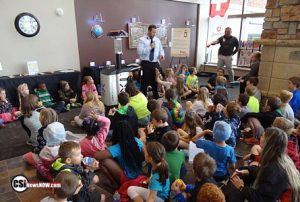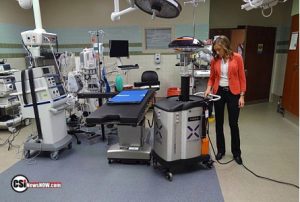 Jamestown (JRMC) — More than 80 elementary students welcomed R.O.S.I.E. Thursday at Jamestown Regional Medical Center.
Jamestown (JRMC) — More than 80 elementary students welcomed R.O.S.I.E. Thursday at Jamestown Regional Medical Center.
R.O.S.I.E. is a Xenex LightStrike Germ-Zapping robot. She kills germs that are difficult to disinfect and difficult to treat.
Bacteria and other germs can be found everywhere – offices, schools, skilled nursing facilities and even hospitals. Despite efforts to clean, superbugs like MRSA and C.diff are resistant to chemicals and common cleaning practices. Superbugs are often antibiotic resistant as well.
Each year these drug-resistant bacteria infect more than 2 million people nationwide, according to the U.S. Centers for Disease Control and Prevention (CDC).
That is why Jamestown Regional Medical Center continues to invest in ways to enhance patient care and safety.
R.O.S.I.E. pulses environmentally friendly xeno n ultraviolet (UV) light and destroys microscopic pathogens that may be lurking on hospital surfaces quickly. R.O.S.I.E. enhances environmental cleanliness by destroying hard-to-kill germs, bacteria and superbugs in hard-to-clean places. JRMC will use R.O.S.I.E. in its operating rooms and patient care areas as an added step to reduce the risk of healthcare associated infections.
n ultraviolet (UV) light and destroys microscopic pathogens that may be lurking on hospital surfaces quickly. R.O.S.I.E. enhances environmental cleanliness by destroying hard-to-kill germs, bacteria and superbugs in hard-to-clean places. JRMC will use R.O.S.I.E. in its operating rooms and patient care areas as an added step to reduce the risk of healthcare associated infections.
More than 80 kindergarten, second and fifth grade students from Lincoln, Washington and Gussner Public Schools celebrated R.O.S.I.E.’s arrival on Thursday, May 17. R.O.S.I.E. stands for “Robot Offering Safe Ideal Environment.”
The children had many questions too, including:
- How can the light kill the germs?
- How long does it take to build?
- Can you demo it right now?
“Everyone that comes into the hospital – patients, families, vendors or even staff – bring germs with them,” said Dane Grebel, JRMC Support Services Manager. “Some of these germs are resistant to even the best cleaning solutions and methods available. Our vision is to be the best rural hospital in the nation. R.O.S.I.E. is one way to do that.”
Surgical site infections are already rare at JRMC. Surgical site infections were reported in only 1 percent of our more than 1,500 procedures last year. Nationwide, the average is 205 percent.
To raise awareness for R.O.S.I.E, JRMC asked the public to participate in a Name the Robot contest. More than 200 children from Jamestown and rural schools submitted coloring pages and suggestions for names. JRMC recognized the winners at the Welcome R.O.S.I.E. event.
“Children and adults helped fundraise for R.O.S.I.E.,” said Lisa Jackson, JRMC Foundation Director. “We couldn’t do it without them. They are THE difference.”
R.O.S.I.E. can disinfect a typical patient or procedure room in 10-15 minutes. Operated by the hospital’s cleaning staff, R.O.S.I.E. can disinfect in any department or unit at JRMC. R.O.S.I.E. is an additional tool for the cleaning staff and does not replace any person or position.
Surgical site infections (SSIs) are rare, said JRMC Quality Manager Jenna Bredahl. Out of 1,571 procedures in 2017, only eight SSIs were reported at JRMC. That’s less than 1 percent. Nationwide, the average rate of SSIs is 2 to 5 percent.
Each SSI can cost the hospital between $15,000 and $50,000. A LightStrike Germ-Zapping Robot costs about $100,000. By preventing just a couple of SSIs, R.O.S.I.E. pays for herself, Jackson said.
“One hospital-acquired infection is too many,” said K.C. DeBoer, JRMC President & CEO. “We take cleanliness seriously. Our patients deserve the best.”
More than 400 healthcare facilities around the world use Xenex’s pulsed xenon UV robots. Numerous health care facilities credit Xenex for helping them reduce their infection rates significantly. Several hospitals have published their C.diff, MRSA and Surgical Site infection rate reduction studies in peer-reviewed journals.












Comments are closed
Sorry, but you cannot leave a comment for this post.